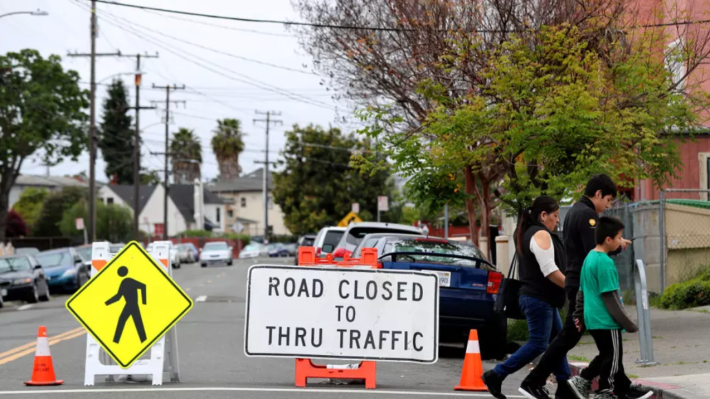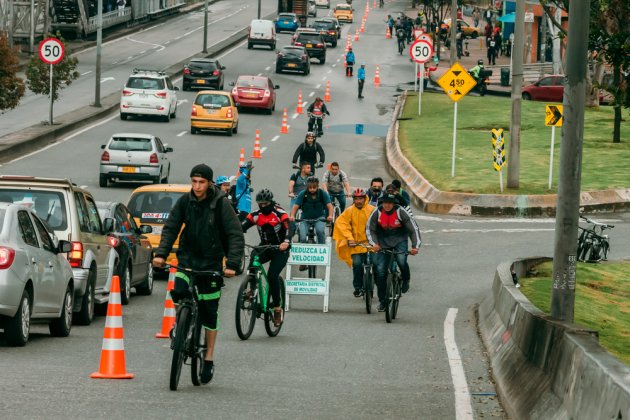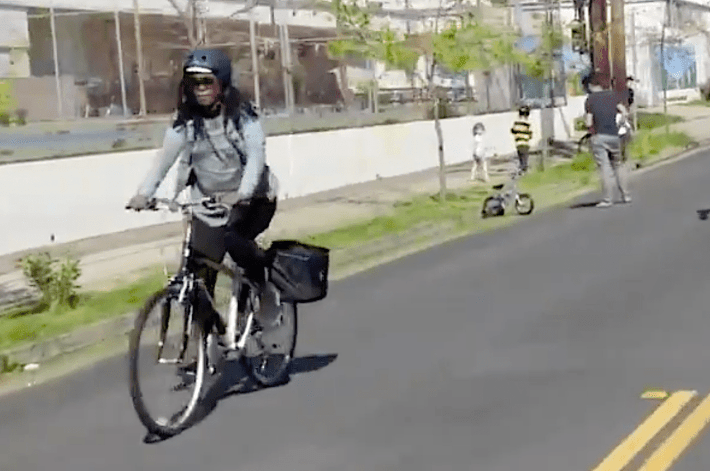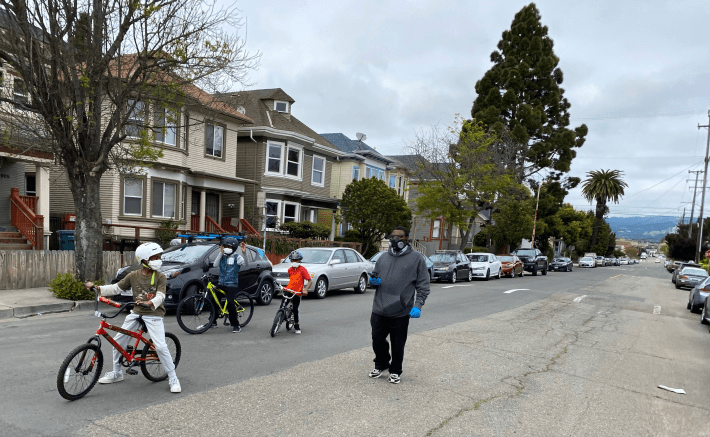To make your voice heard on open streets and Slow Streets reach out to Mayor Lori Lightfoot, your local alderman, and the Active Transportation Alliance and sign essential worker Kyle Lucas’ petition for open streets and reopening the Lakefront Trail, which currently has almost 1,200 supporters. You can also tweet to Lightfoot and ATA: @chicagosmayor and @activetrans.
There was a bit of a breakthrough yesterday when the Active Transportation Alliance softened its previous de-facto opposition to the open streets movement a bit. In an April 7 blog post, the advocacy group put out a laundry list of reasons why Chicago shouldn’t ban or restrict car traffic on roadways to open them up for safe, socially-distanced walking and biking during COVID-19:
- “The context of a pandemic does not seem like the most appropriate moment to be pushing forward this vision.”
- "Planning, implementing, and managing an Open Streets initiative requires significant city resources.”
- "Closing streets in Chicago would almost certainly mean police presence at each of these streets, which we know has negative connotations for Black and Brown communities.”
- “The needs of this moment mean we must do... a lot less [walking and biking], if at all.”
Like many Chicago sustainable transportation advocates, I am disappointed by that position. I was honestly shocked that Active Trans didn't immediately support open streets considering that its stated mission is to “is to advocate for walking, bicycling, and transit.”
In fairness, a lot has happened since then. Shortly after ATA released that statement, Oakland announced its innovative plan for “Slow Streets,” prohibiting through traffic on a 74-mile network of side streets, while allowing vehicular access to local destinations for residents, delivery personnel, and first responders. It’s cheap and quick to implement, and requires no new policing, which addresses some of ATA’s concerns. And since it provides many of the benefits of a full street closure with minimal hassles for drivers, it seems like the best model for open streets.

Cities like New York, San Francisco, and Portland have since announced major Slow Streets program, and at this point just about every blue-state big city except Chicago is doing some kind of open streets intervention. We’d also like to think that Streetsblog Chicago’s constant drum-beating on the issue had an influence on ATA.
The advocacy group published a new blog post yesterday that opened the door a bit to the possibility of open streets in Chicago. “We are excited to see [open streets] being adopted by more people and places,” the new post stated.
But disappointingly, the new statement still falls short. “Tepid” is is the word that comes to mind.
In the blog post, ATA basically abdicates its responsibility to fight for safer streets. Instead it argues that “Creating more road space for walking and biking in your community should be a locally-driven effort,” spearheaded by civilians.
The advocacy group then states that before residents of Chicago neighborhoods or suburbs launch campaigns for open streets in their communities, they need to ask themself a long list of equity-related questions to help make sure the program wouldn’t have any unintended consequences or do harm. That's certainly an important goal. Here's an example of one of the eight paragraph-length questions:
Are there resources and bandwidth for this? Keep in mind that municipal staff, including public works professionals, may have limited capacity right now. In some communities, staff are focused solely on responding to the pandemic. For safety and liability reasons, cities may require staff to issue permits, place traffic safety equipment, and post specialty signage. Ask yourself if open streets will divert attention and resources away from those most in need.
I don't necessarily disagree with that line of questioning. But in that lengthy list, ATA raises lots of potential equity impacts of doing open streets. I wonder, has the advocacy group interrogated the possible social justice consequences of maintaining the status quo -- that is, not creating more space for safe walking and biking during the pandemic -- in the same way?
If we take no action right now to make these modes more practical and appealing, when Stay at Home is lifted but many people are still avoiding transit, there’s going to be a major spike in driving. That means more car-dependency, congestion, pollution, and crashes than before the pandemic. How is that supposed to help Chicago’s marginalized communities?

I don’t think this has to be a matter of “Either we do open streets or we assist essential workers” or “We have to choose between Slow Streets or addressing unemployment, homelessness, and hunger.” There are plenty of brilliant minds in the world who can come up with strategies to address multiple needs at once. Perhaps the roll-out of Slow Streets in low-income communities on Chicago’s South and West sides could involve distributing free food and bikes, an idea suggested by Torrey Barrett, CEO of the Washington Park–based KLEO Community Family Life Center.
Oakland mobility director Warren Logan said in a Streetsblog USA interview that a major goal of that city's Slow Streets program was to make it easier for low-income people without cars to do essential trips. But ATA seems to view open streets initiatives as relatively frivolous recreational programs that ignores the needs of at-risk workers and people struggling economically.
That perception is somewhat understandable, since calls for open streets are largely coming from dense, relatively affluent North Side neighborhoods where sidewalk crowding is more of an issue and more people are currently working from home. And it’s true that most South and West side residents are not clamoring for slow streets (although we interviewed several who said Slow Streets sounds promising.) But that doesn’t mean there's no need for safer walking and biking routes in Black and Latinx communities, or that residents in those areas wouldn’t take advantage of open streets.

If we could create Slow Streets that parallel crowded bus lines or, better yet, a citywide network of these routes, that could make it safe and comfortable for essential worker to commute by bike. Combined with the fact that Divvy memberships are half-off during the pandemic, and it recently became possible for low-income people to sign up for $5 Divvy for Everyone memberships online, these low-stress corridors could create a practical new transportation option.
Another thing that bothered me about the ATA post was this passage implying that while there’s a high demand for open streets on the majority-white North Side, African-American and Latinx residents on the South and West sides probably wouldn't interested in them.
In other places, however, crowded sidewalks are less of a concern. Many communities, especially Black and Brown communities, have higher concentrations of essential workers who don’t have the privilege of working from home.
These communities are struggling with disproportionately high COVID-19 exposure and death rates, and in many cases, financial insecurity, homelessness, hunger, and other pressing concerns. Closing streets for cycling and walking may not be the top priority in these communities.
I’m not the only one who found this tone-deaf. “We can disagree over the best ways to implement open streets, but I hope we can all agree that ‘only in the white parts’ is the absolute worst way to do it,” tweeted the person behind the Star Line Chicago account. They noted that, although ATA seems to believe making more room for walking and biking is not a top priority for POC residents right now, “that doesn’t mean it isn’t a priority for them at all, or that they believe open streets do not belong in their community.”

I can't help but reflect on the disconnect between the mainstream transportation advocacy community and BIPOC (Black and Indegenous People of Color) communities. There is a dearth of Black and Brown representation in urbanist, sustainable transportation, and liviable streets spaces but, indeed, that’s not to say these transportation issues aren’t being pondered by African-American and Latinx people.
And, again, I was disappointed that ATA is essentially passing the buck for advocacy to individuals as opposed to using its power as an influential organization to lobby for open streets and Slow Streets. Readers of the ATA post who want open streets are told to create their own campaign and engage their elected officials. In some ways this is the wrong strategy, considering that Chicago’s City Council is currently only meeting once a month, and Slow Streets probably could be accomplished sooner by ATA directly lobbying the mayor. She did, after all, gain lots of clout when many aldermen recently voted to give her emergency powers.
While the latest ATA post said some nice things about open streets, in some ways it also poured water on the movement to make it happen in Chicago by suggesting that there are still lots of reasons not to do it. Fortunately the campaign for Slow Streets -- and safer, more sustainable transportation in general -- is bigger than just one advocacy organization. The battle to make more space for safe walking and biking in our city has just begun.





